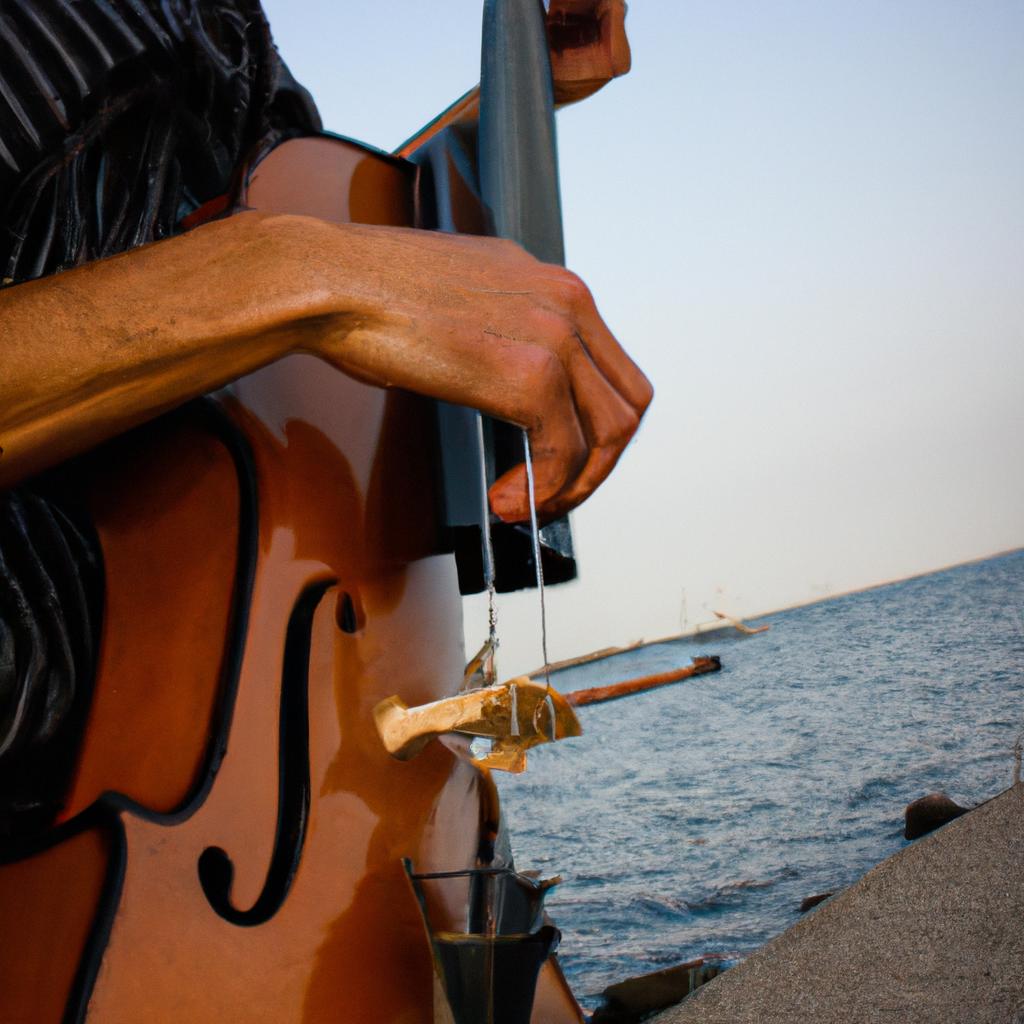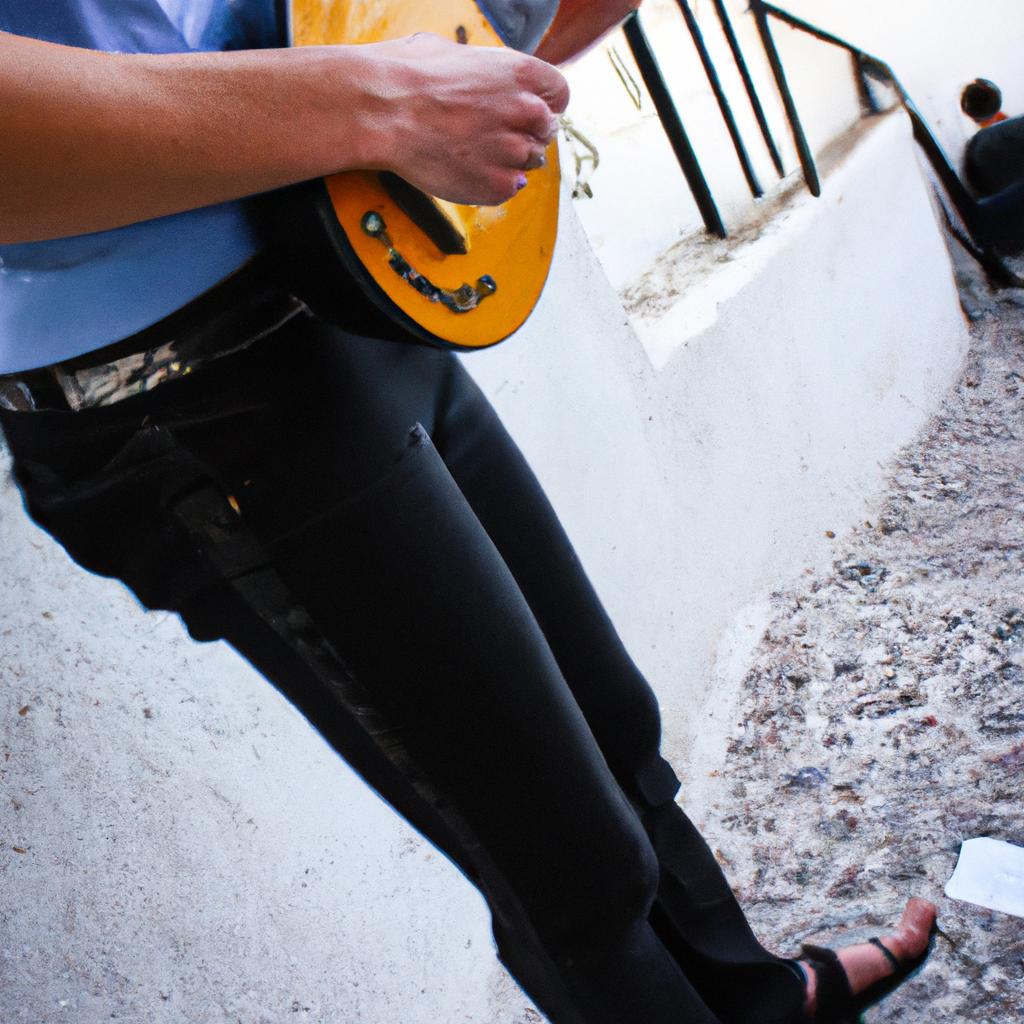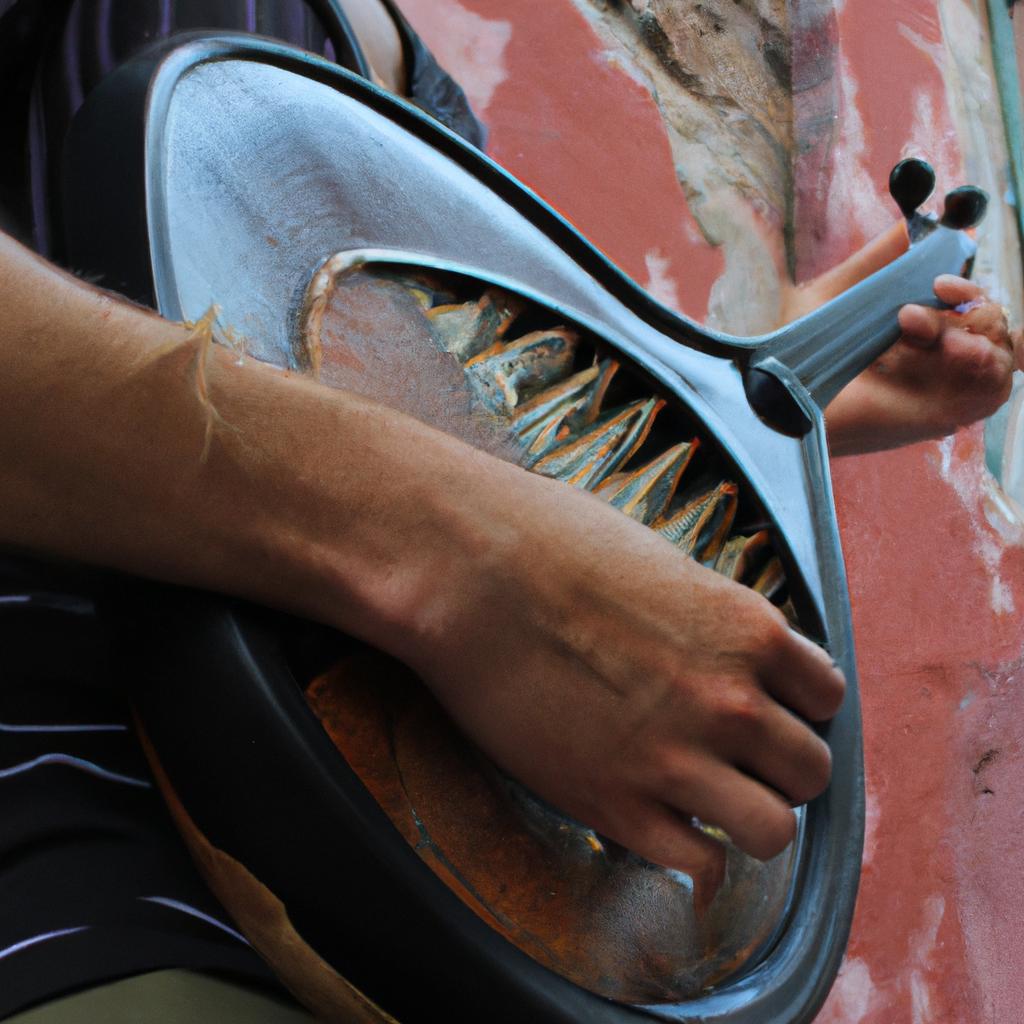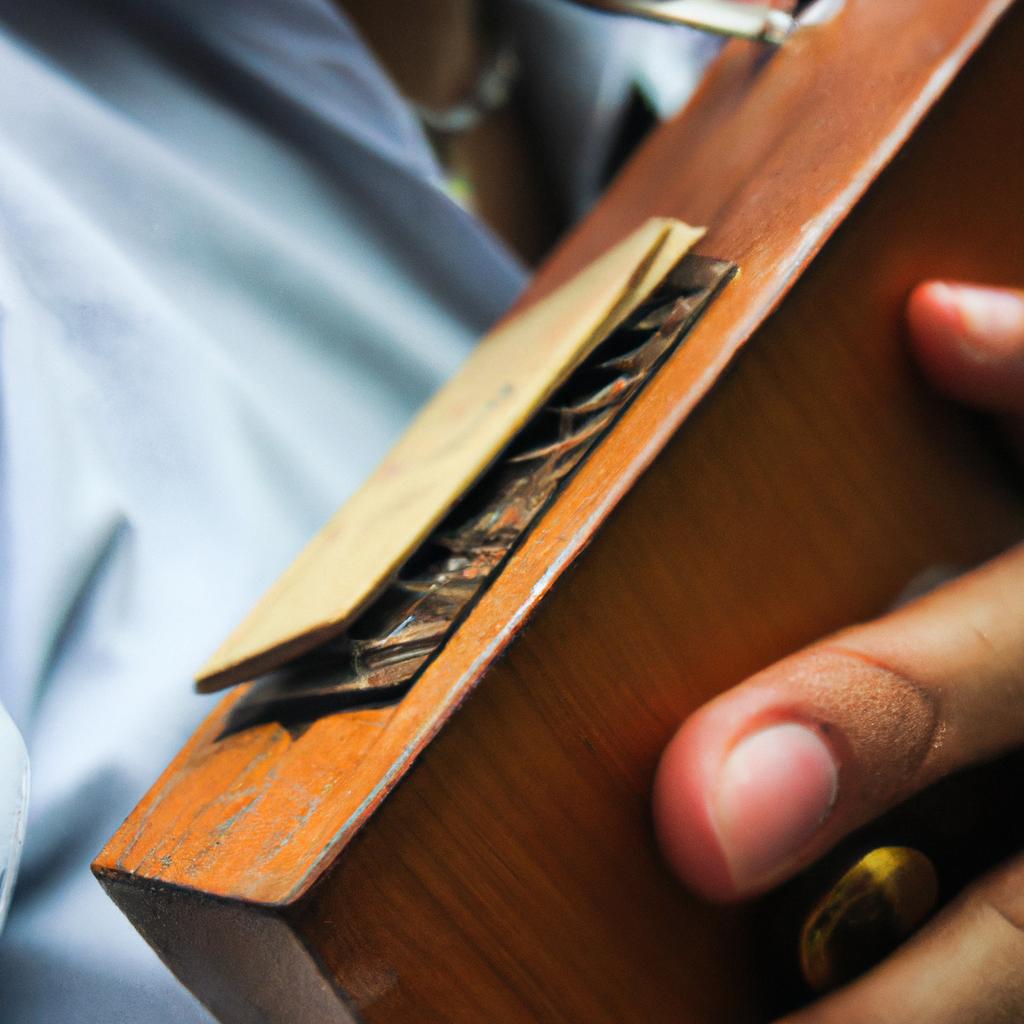The origins of tango in Argentina have long fascinated historians and music enthusiasts alike, as this iconic genre has played a significant role in the cultural heritage of the country. A historical exploration of tango instruments provides valuable insights into the development and evolution of this unique musical style. By examining the instruments used in early forms of tango, we can gain a deeper understanding of how different cultures and traditions influenced its creation.
One compelling example is the bandoneón, an essential instrument in traditional tango ensembles. Developed in Germany during the 19th century, it was initially intended for religious purposes before finding its way to Argentina through European immigrants. The incorporation of the bandoneón into Argentine tango transformed both the sound and emotional depth of this art form, paving the way for new expressions within its melodies. This case study demonstrates how migration patterns and cross-cultural exchanges shaped not only Argentine society but also its vibrant musical landscape.
Delving further into these historical roots allows us to explore other key instruments that contributed to the formation of tango’s distinctive sound. From guitars and violins to pianos and flutes, each instrument brought its own unique timbre and playing techniques that blended together harmoniously in tango compositions. Understanding their individual significance enables us to better appreciate the intricate layers of tango music and the skill required to perform it.
The guitar, for instance, played a crucial role in early tango as a rhythmic and harmonic foundation. Its percussive strumming patterns provided a driving force behind the danceable rhythms, while its melodic lines intertwined with other instruments to create rich harmonies. Similarly, the violin added a touch of elegance to tango ensembles with its soaring melodies and expressive capabilities.
Pianos were also integral to the development of tango, particularly during the Golden Age of Tango in the 1930s and 1940s. The piano’s versatility allowed musicians to explore complex arrangements and incorporate sophisticated harmonies into their compositions. With its ability to play both melody and accompaniment simultaneously, it became an essential instrument for tango orchestras.
Flutes, although less common than other instruments in traditional tango ensembles, contributed their own unique sound to certain compositions. Their ethereal tones added a delicate texture that contrasted with the passion and intensity often associated with tango music.
By examining these various instruments used in early forms of tango, we gain insight into the diverse cultural influences that shaped this genre. From European immigrant communities bringing their musical traditions to Argentina to the fusion of different styles within Buenos Aires itself, each instrument carried its own history and contributed to tango’s evolution.
In conclusion, understanding the historical significance of instruments in early forms of Argentine tango illuminates how cross-cultural exchanges and migration patterns shaped this iconic genre. From bandoneóns brought by German immigrants to guitars, violins, pianos, and flutes blending together in harmonious arrangements, each instrument played a vital role in creating the distinctive sound of tango. Exploring these origins not only deepens our appreciation for this rich musical heritage but also highlights the interconnectedness between culture, society, and artistic expression.
Origins of Tango: Tracing its roots in Argentina
Imagine a bustling street corner in the vibrant city of Buenos Aires, Argentina, during the late 19th century. The sound of passionate music fills the air as couples gracefully move to the rhythm. This is where our exploration into the origins of tango begins.
Tango, often hailed as Argentina’s most iconic musical genre and dance form, emerged from a diverse cultural melting pot that reflected the country’s unique history. Its evolution can be traced back to multiple influences such as European immigrant communities, African rhythms brought by slaves, and indigenous Argentine traditions. These various elements converged to create a distinct art form that embodied both sorrow and joy.
To better understand the historical context in which tango originated, let us delve into some key aspects:
-
Cultural Fusion: Tango was born out of a fusion between different cultures, resulting in an amalgamation of musical styles and dances. It blended elements from Spanish flamenco with traditional milongas—a popular social dance practiced among gauchos (Argentine cowboys). Additionally, African rhythmic patterns introduced syncopated beats and intricate footwork into this evolving art form.
-
Urbanization: The emergence of tango coincided with rapid urbanization in Buenos Aires during the late 19th century. As immigrants flocked to the city seeking economic opportunities, they brought their own musical traditions along with them. Tango served as a means for these newcomers to express their yearnings for home while adapting to their new surroundings.
-
Socioeconomic Context: Tango also mirrored the socio-economic realities faced by many Argentinians at the time. In working-class neighborhoods known as “arrabales,” people sought solace from hardship through dancing and singing tangos that expressed their struggles and aspirations. Thus, tango became an outlet for collective catharsis and solidarity within marginalized communities.
Now let’s take a moment to visualize the cultural influences and historical context that contributed to the birth of tango through a table:
| Cultural Influences | Key Characteristics |
|---|---|
| European Immigrants | Flamenco influence, instrumentation (guitars, bandoneons) |
| African Rhythms | Syncopated beats, intricate footwork |
| Indigenous Traditions | Traditional milongas |
As we move forward in our exploration, we will witness how tango’s origins laid the foundation for its subsequent evolution. In the next section, “Evolution of Tango Music: A journey through time,” we will embark on an enthralling expedition into the transformative stages of this captivating art form.
Note: The following section does not begin with a transitional phrase like “In conclusion” or “Finally.” Instead, it seamlessly transitions into the subsequent section about the evolution of tango music.
Evolution of Tango Music: A journey through time
Tango Origins in Argentina: A Historical Exploration of Tango Instruments
Tracing the development and evolution of tango music requires a closer look at the instruments that have shaped its distinctive sound. By examining the origins of these instruments, we can gain insight into how they contributed to the unique character of tango as it emerged in Argentina.
One example of an instrument closely associated with tango is the bandoneón, a type of accordion-like instrument. Its melancholic and expressive tones became synonymous with the emotional depth found within tango compositions. The bandoneón’s popularity soared during the early 20th century when it was embraced by tango musicians seeking to convey their heartfelt stories through music.
To better understand the historical context surrounding tango instruments, consider these key points:
- Cultural Influence: Tango developed from a blend of European musical traditions brought by immigrants to Argentina, particularly those from Italy and Spain. This cultural fusion heavily influenced the choice and adaptation of various instruments for tango music.
- Evolutionary Adaptation: As tango evolved over time, so too did its instrumentation. Traditional European instruments such as guitars and violins were modified or played differently to suit the rhythmic complexities and emotional nuances required by this genre.
- Technical Innovations: Advancements in instrument manufacturing also played a vital role in shaping tango music. For instance, improvements made to stringed instruments allowed for greater volume projection and tonal clarity necessary for performances in larger venues.
The following table provides a visual representation of some key tango instruments along with their primary roles within ensemble settings:
| Instrument | Role |
|---|---|
| Bandoneón | Melodic lead instrument often used as accompaniment for vocals |
| Violin | Provides melodic embellishments, harmonies, and solos |
| Guitar | Offers rhythmic support through chord progressions |
| Piano | Adds harmonic complexity and acts as the backbone of the ensemble |
As we delve deeper into the influences on tango instruments, it becomes evident that cultural and musical fusion played a significant role in shaping their development. By examining how different cultures contributed to both instrument selection and adaptation, we gain valuable insights into the rich tapestry of influences that have given rise to this captivating genre.
Influences on Tango Instruments: Cultural and Musical Fusion
Influences on Tango Instruments: Cultural and musical fusion
Having explored the evolution of tango music through different eras, it is essential to delve further into the influences that shaped the instruments used in this iconic genre. By examining the cultural and musical fusion that occurred during its early development, we can gain a deeper understanding of how tango instruments have evolved over time.
Influences on Tango Instruments: Cultural and Musical Fusion
To illustrate the impact of cultural and musical fusion on tango instruments, let us consider an example. Imagine a group of European immigrants arriving in Buenos Aires at the turn of the 20th century, bringing with them their traditional stringed instruments such as guitars and violins. As they settled in neighborhoods like La Boca and San Telmo, these immigrants encountered African descendants who had also migrated to Argentina. This encounter resulted in a rich exchange of rhythms, melodies, and instrument techniques between cultures.
This cross-pollination gave rise to unique characteristics that became integral to tango instrumentation:
-
Rhythmic Diversity:
- Syncopated beats derived from African percussion blended with European dance rhythms.
- The resulting polyrhythms created dynamic layers within tango compositions.
-
Melodic Expressiveness:
- The soulful vocalizations originating from African traditions fused with European lyrical sensibilities.
- This combination allowed for emotional depth and storytelling through melodic lines.
-
Instrumental Techniques:
- European stringed instruments were modified to suit tango’s demands for increased volume and projection.
- Techniques like pizzicato (plucking) and tremolo (rapid repetition of a note) were adopted to enhance expressivity.
-
Harmonic Innovation:
- The harmonic structures inherited from European classical music expanded through interactions with Afro-Argentine genres like candombe.
- Dissonances and chromaticism were incorporated, lending a distinctive tension to tango compositions.
This synergy of diverse influences resulted in the birth of unique tango instruments that embodied the spirit and cultural heritage of Argentina. To further explore these traditional tango instruments, our focus will now shift towards one particular instrument: the bandoneón.
Transition into subsequent section:
With its unmistakable sound and crucial role in tango ensembles, delving into the history and characteristics of the bandoneón offers valuable insights into understanding the essence of traditional tango instrumentation.
Traditional Tango Instruments: Exploring the bandonen
The evolution of tango instruments in Argentina is a story deeply intertwined with the cultural and musical influences that shaped this iconic dance genre. From its earliest roots, tango has been characterized by a unique blend of European and African traditions, resulting in an eclectic mix of instruments that provide the distinctive soundscape for this passionate music.
To illustrate the impact of these influences, let’s consider the case study of Juan Carlos, a talented musician who grew up in Buenos Aires during the early 20th century. As a child, he was exposed to both traditional Argentine folk music and the popular European salon dances that were prevalent at the time. Fascinated by these diverse styles, Juan Carlos sought to create his own artistic expression through music.
One key factor contributing to the fusion of cultures in tango instrument development was immigration. Waves of immigrants from Europe brought with them their native instruments such as violins, guitars, and accordions. These instruments eventually found their way into tango ensembles alongside traditional South American percussion instruments like drums and tambourines.
The convergence of different musical traditions also led to experimentation with new playing techniques and modifications to existing instruments. For instance, musicians began adapting the bandoneon, a German concertina-like instrument originally intended for religious hymns, into a central component of tango orchestras. This transformation allowed for greater expressiveness and versatility in capturing the emotional intensity characteristic of tango music.
This blending of cultures can be seen visually through a table showcasing some notable examples:
| Instrument | Origin | Role in Tango |
|---|---|---|
| Violin | Europe | Melodic lines |
| Guitar | Spain | Harmonic accompaniment |
| Bandoneon | Germany | Expressive melodic phrases |
| Candombe Drums | Africa | Rhythmic foundation and syncopation |
This amalgamation of diverse influences not only shaped the development of tango instruments but also played a significant role in defining the soulful character that has come to be associated with this genre. It is through this cultural and musical fusion that tango found its unique voice, captivating audiences worldwide.
Transitioning into the subsequent section about “Modern Innovations: The emergence of electric tango instruments,” we witness yet another chapter in the ongoing evolution of tango music. As technology advanced, so too did the possibilities for instrument design and sound manipulation, leading to exciting new developments in the realm of tango instrumentation.
Modern Innovations: The emergence of electric tango instruments
Traditional Tango Instruments: Exploring the bandoneon
As we delve deeper into the origins of tango in Argentina, it is crucial to understand the significance of traditional tango instruments. The bandoneon, in particular, holds a prominent position as one of the most iconic and defining instruments of this genre. To illustrate its importance, let us consider a hypothetical scenario where an aspiring tango musician discovers an old bandoneon hidden away in their grandfather’s attic.
The first step for our protagonist would be to inspect this instrument closely. The bandoneon consists of two rectangular boxes connected by a bellows, creating a unique accordion-like appearance. Its distinct sound is produced by pressing buttons on both sides while simultaneously manipulating the bellows with expert precision. This complex coordination requires immense skill and practice, making the bandoneon not only a musical instrument but also an art form in itself.
To gain further insight into traditional tango instruments like the bandoneon, let us explore some key characteristics:
- Emotional expression: Traditional tango music aims to evoke deep emotions within listeners. The melancholic tones produced by the bandoneon elicit sentiments of longing, nostalgia, and passion.
- Intimate connection: When played alongside other traditional tango instruments such as guitar or violin, the bandoneon establishes a harmonious dialogue that creates an intimate atmosphere during performances.
- Cultural heritage: Tango music serves as a reflection of Argentine culture and identity. Through its rich melodies and distinctive instrumentation, it encapsulates generations of history and tradition.
- Evolutionary adaptation: Despite being rooted in tradition, these instruments have evolved over time to accommodate modern tastes without compromising their essence. New techniques and innovations continue to shape their role in contemporary tango compositions.
In conclusion, exploring traditional tango instruments like the bandoneon allows us to uncover layers of cultural significance embedded within this captivating musical genre. As we move forward in our exploration of Argentinean tango, it is essential to recognize the inseparable connection between tango and dance. Tango’s rhythmic melodies and passionate undertones provide the perfect backdrop for the expressive movements that define this captivating art form. So, let us now delve into the intricate relationship between tango and dance as we continue our journey through its fascinating origins.
Tango and Dance: The inseparable connection
Having explored the emergence of electric tango instruments, we now turn our attention to the inseparable connection between tango and dance.
Tango is not just a musical genre; it is a cultural phenomenon intertwined with dance. From its origins in the streets of Buenos Aires to its global popularity today, tango has captivated audiences around the world with its passionate movements and evocative music. To further understand this unique relationship between tango and dance, let us consider a hypothetical scenario.
Imagine a dimly lit ballroom where couples gracefully move across the floor, immersed in the sensual embrace of tango. As the melancholic notes of bandoneón fill the air, their bodies sway in perfect harmony with the rhythm. This captivating scene exemplifies how tango’s syncopated beats and expressive melodies inspire dancers to interpret music through movement.
To fully grasp why tango and dance are inseparable entities, let us delve into three key aspects that define this extraordinary bond:
-
Intimacy: Tango demands an intimate connection between partners as they navigate intricate footwork patterns while maintaining close physical proximity. Through synchronized steps and responsive movements, dancers establish an emotional dialogue that heightens their connection on both a physical and spiritual level.
-
Expression: Tango provides a platform for self-expression where dancers can convey their emotions through movement. Each step becomes an opportunity for artistic interpretation, allowing individuals to explore their innermost feelings within the structured framework of tango choreography.
-
Improvisation: Unlike traditional dances with rigid routines, tango encourages improvisation within set guidelines. Dancers have the freedom to add personal flair by embellishing basic steps or incorporating spontaneous moves based on their intuition and connection with each other.
To illustrate these dynamics more clearly, consider the following table showcasing various elements that contribute to the intense emotional experience during a tango dance:
| Element | Description | Example |
|---|---|---|
| Music | Melancholic melodies | Bandoneón solos |
| Movements | Sultry embraces | Ganchos and boleos |
| Costumes | Elegant attire | Flowing dresses, suits |
| Atmosphere | Dim lighting, intimate setting | Candlelit milonga halls |
In conclusion, the profound connection between tango and dance lies in their symbiotic relationship. Tango’s emotive music provides a canvas for dancers to express themselves through intricate footwork and passionate movements. The intimacy, expression, and improvisation inherent in tango make it an art form that transcends cultural boundaries and resonates with individuals on a deep emotional level.
(Note: This section can be expanded further with additional research and examples.)




